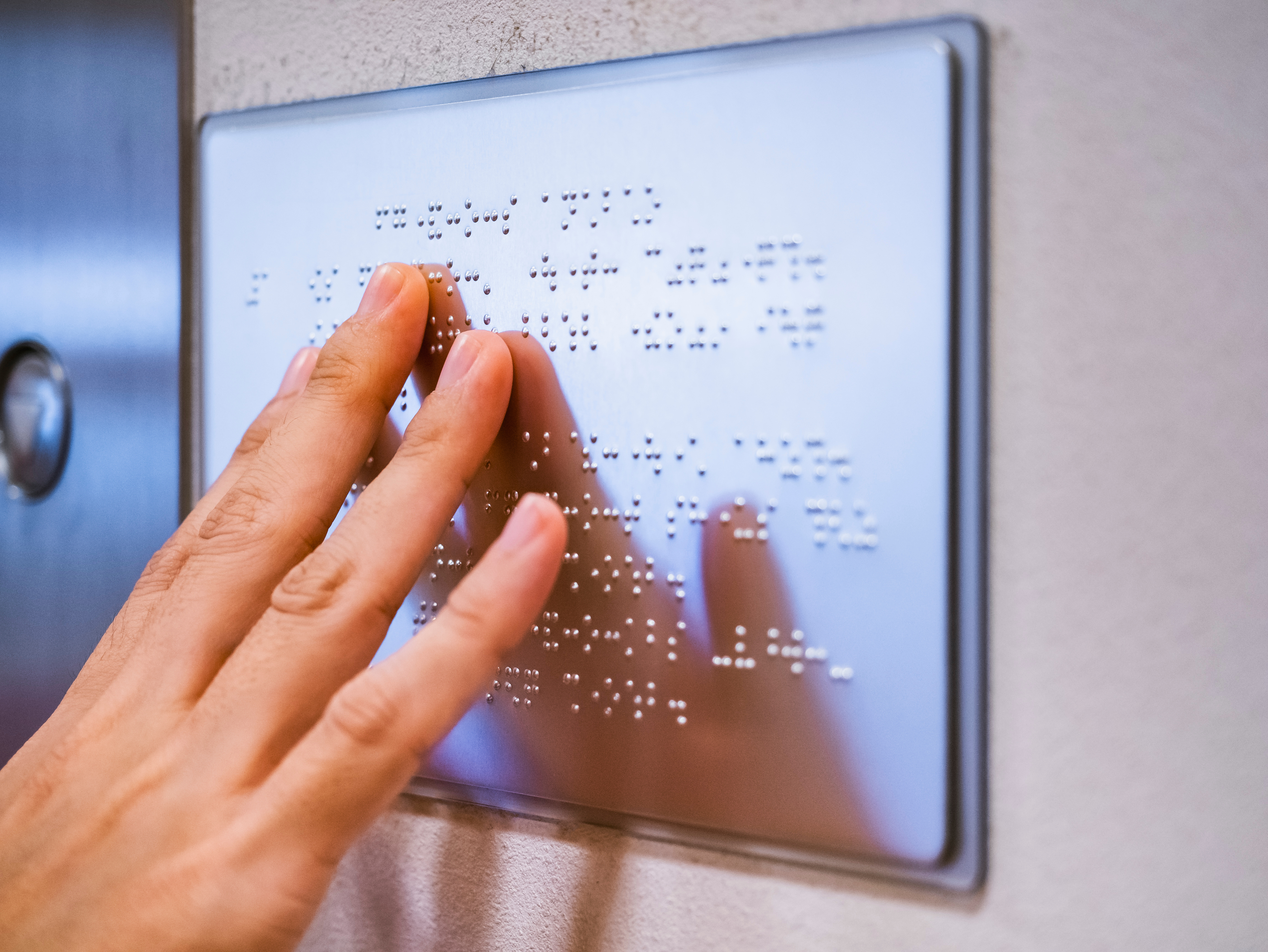Essential Tips for Incorporating Braille into Signage, Menus, and Materials

Welcome to CNIB Beyond Print’s guide to enhancing inclusivity and accessibility within your organization!
Whether you’re just starting out or looking to improve existing efforts, integrating braille into your business can significantly benefit people who are Blind, Deafblind and Low Vision.
This post aims to offer practical steps on incorporating braille signage, menus, and materials, to help your business or organization reflect their commitment to inclusivity while also ensuring accessibility for all.
Understanding the Importance of braille

Braille is not merely a form of communication; it represents accessibility, independence, and equality for people who are blind, Deafblind or low-vision.
For many people with sight loss, braille is a crucial tool for navigating public spaces, accessing information, and participating fully in society.
As businesses strive to cater to diverse customer bases, integrating braille emerges as a powerful tool to bridge the accessibility gap for people who are blind or partially sighted.
By implementing braille in your business, you’re not just complying with legal standards for accessibility but also embracing a broader commitment to inclusivity.
Starting with Braille Signage
Braille signage plays a crucial role in ensuring accessibility for the blind and Deafblind community, allowing for greater independence and safety in navigating both public and private environments.
According to research by CNIB, 81% of people who are blind or partially sighted reported that inaccessible signage is a significant barrier to their mobility and independence.
By incorporating braille into your organization’s signage, you can significantly improve the user experience for people with sight loss, ensuring they feel welcomed and valued.
Here are some steps to effectively implement braille signage:
- Assess Your Needs: Begin by evaluating the areas within your organization where accessible signage is crucial. This includes important landmarks such as entrances, restroom facilities, elevator buttons, and room identifiers.
- Follow Legal Requirements: Ensure compliance with local and international accessibility standards. These often dictate specifics about the size, location, and contrast of braille signage.
- Inclusive Design Principles: Braille signage should be designed with contrast and tactile elements in mind. Signs should be placed at consistent heights and locations to ensure predictability and ease of access.
- Professional Guidance: Consulting with users with lived experience and accessibility experts can ensure that your signage meets both the functional needs of people with disabilities and the aesthetic values of your brand.
- Adhere to Best Practices: Our braille portal offers a comprehensive list of resources on braille spacing and layout guidelines. Visit our portal to access these valuable resources and ensure your braille materials are clear and well-structured.
Integrating Braille Menus

In the hospitality industry, accessibility is not just about physical access but also about providing information in formats that everyone can use.
Over 8 million Canadians live with a degenerative eye-disease, and 1.5 million Canadians live with sight loss. This number is expected to soar by 33% by 2050.
People with sight loss dine out like everyone else, and by implementing braille and large print menus, coupled with accessible ordering systems, their experience can be significantly enhanced.
By offering braille menus, restaurants can promote inclusivity and increase their customer base.
Here are key steps to integrate braille menus effectively:
- Menu Design: Similar to signage, braille menus should be clear and easy to navigate. Consider the layout and grouping of items for intuitive navigation.
- Regular Updates: Just as with your standard menus, ensure that your braille menus are updated to reflect changes in your offerings.
- Training Staff: Educate your team on the importance of these menus and how to present them to guests who use braille.
- Feedback Loop: Encourage feedback from braille users and be ready to make adjustments to improve the usability of your menus.
- Adhere to Best Practices: Our braille portal offers a comprehensive list of resources on braille spacing and layout guidelines. Visit our portal to access these valuable resources and ensure your braille materials are clear and well-structured.
Expanding Braille Offerings
Extending braille beyond signage and menus to other materials can significantly boost your brand’s reach and demonstrate a strong commitment to inclusivity.
Providing information in braille can help people who are blind or partially sighted feel more connected to your brand and more confident in their interactions with your services.
Steps to expand your braille offerings include:
- Marketing Materials: Providing brochures, business cards, and other promotional items in braille can enhance your reach and show a proactive stance on inclusivity.
- Online Accessibility: Beyond physical braille, ensure your website and digital platforms are accessible. This includes screen reader compatibility and options to request information in braille.
- Event Accessibility: For events, offer materials in braille and alternative formats, including agendas, speaker notes, and informational brochures.
- Adhere to Best Practices: Our braille portal offers a comprehensive list of resources on braille spacing and layout guidelines. Visit our portal to access these valuable resources and ensure your braille materials are clear and well-structured.
Implementation Steps
Successfully implementing braille within your organization involves a structured approach, from planning through to execution and review. But it doesn’t have to be overtly difficult, expensive, or complicated.
Here’s how to get started:
- Conduct an Audit: Identify where your organization lacks in accessibility and inclusivity. This can range from physical spaces to digital platforms.
- Set Clear Goals: Establish what you aim to achieve with your braille integration. Goals should be specific, measurable, and tied to broader inclusivity initiatives.
- Allocate Budget and Resources: Implementing braille solutions will require budgeting for production and potentially training staff.
- Collaborate with Experts: Partner with organizations in the accessibility space to ensure your materials are accurate and effective. Their expertise can guide you from planning to execution and beyond.
- Monitor and Adapt: Once braille options are in place, continuously monitor their effectiveness and gather user feedback to make necessary improvements.
- Adhere to Best Practices: Our braille portal offers a comprehensive list of resources on braille spacing and layout guidelines. Visit our portal to access these valuable resources and ensure your braille materials are clear and well-structured.
Conclusion
Incorporating braille into your business isn’t just about adhering to accessibility laws—it’s about opening up your services to a wider audience, enhancing the customer experience, and creating a more inclusive community.
While the journey toward full inclusivity is ongoing, starting with braille signage, menus, and materials can make a significant impact.
If you’re ready to take the next step in making your organization more accessible and inclusive, CNIB Beyond Print is here to help. With our expertise in accessibility consulting and creating alternative formats, we can assist you in ensuring that your business is welcoming to everyone. Connect with us today to learn more about our services and how we can support your goals in accessibility and inclusivity.
Transforming your business to be more inclusive is not just a good business practice—it is a vital one.
Let’s make accessibility a standard, not an afterthought.
